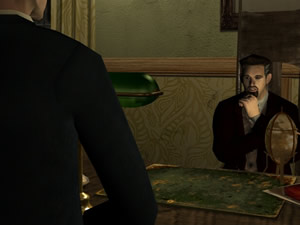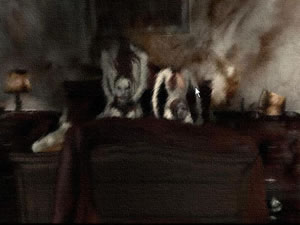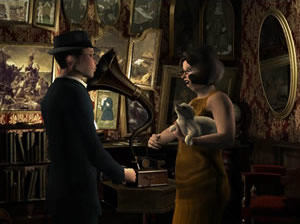We need an autopsy.
Paris, 1920’s – a grisly double murder has taken place. An American couple on
vacation has been found dead in their room. Their heads were cleanly removed and
placed upon their seated laps.
Elsewhere
in Paris, Gus MacPherson, expatriate and former detective, has settled into
his new life. But everything is about to change, because Gus is pulled out of
retirement to solve this dark murder mystery.
Post Mortem, an adventure game from the same people who brought us
the solid Syberia, unfortunately doesn’t measure up
in comparison. While Post Mortem‘s overall plot has some interesting
points, the dialogue and writing are bland and at times even sloppy. Chalk it
up to translation woes from its native French release.
Post Mortem uses a first-person point and click setup similar to MYST.
Think of it like being glued to the floor with a bubble around you. You can
look nearly every which way within the bubble, but you can’t move in a direction
unless it is permitted.
It’s a pseudo first-person perspective, taking you from one point of interest
(POI) to another. This might have been effective in the past, but that control
style is somewhat antiquated. How realistic is it really to have your feet glued
to the ground? It feels dated and old. Perhaps the game could have been done
more effectively in a third-person perspective or even in real-time with a full
range of movement.
As you move from POI to POI, you must search for “hotspot” items and people
to manipulate and interact with through conversations or puzzles. The puzzles
are the familiar fare, usually just inventory-based or simple object puzzles
very much in the MYST vein. In comparison to other adventure games, more
emphasis is placed upon the conversations.
Depending on the choices you make during conversations, you are steered into
different puzzles and events, ultimately ending up with one of a few different
endings. It’s a clever way to change up the gameplay a bit and introduce an
element of variety to what is often a very linear game genre. The fact that
the dialogue trees lead to a branching plot is much appreciated, but the reality
of the branching is messy. Sometimes, items and events come up or are spoken
of when they have yet to be properly introduced in the story.
 Visually,
Visually,
Post Mortem has its ups and downs. The different environments are pre-modeled
with a moody but muddy atmosphere. The architectural designs of the buildings
and props fit the period setting, but the character modeling is only fair. Gus
looks a bit like GR editor-in-chief Ben Silverman, and since Ben is funny, it
makes it hard for me to take Gus seriously. [Why thank you, I think. – Ed.]
But what really takes me away from the serious nature of Post Mortem
are the shoddy character animations. The characters fidget and jerk in repetitive,
awkward ways. It really gets distracting and pulls you out of the narrative.
Less movement would be have been far more effective.
Besides the awkward body animations, the characters move their mouths in Mr.
Ed fashion as if strings were tied to their lips. There should have been more
range to their mouth movements, or at the very least, the mouths shouldn’t have
opened so wide.
And when their mouths open, some less than stellar voice acting spouts out. These voices cannot be skipped either. However, the sound effects effectively add to the eerie backdrop of the game.
While the darker setting and plot markes a change from adventure game norms
and the branching story is a cool feature, the game drowns in execution problems,
from the poor writing to the bad “acting” and errant branching criss-cross errors.
Time to read Post Mortem its last rites.

-
Moody environments
-
Mysterious, dark plot
-
Branching
-
Which doesn't work very well
-
Poor writing/translation
-
Weak voices
-
Character animation: Less is more
-
Dated interface







